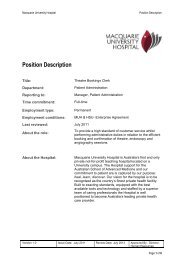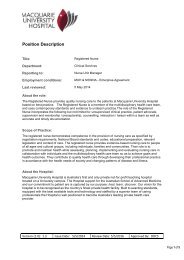Plenary Oral Presentations - Macquarie University Hospital
Plenary Oral Presentations - Macquarie University Hospital
Plenary Oral Presentations - Macquarie University Hospital
You also want an ePaper? Increase the reach of your titles
YUMPU automatically turns print PDFs into web optimized ePapers that Google loves.
16 th International Meeting of the Leksell Gamma Knife ® SocietyMarch 2012, Sydney, AustraliaMA-309WBRT usage in patients getting SRS for >5 brain metastases1Jonathan Knisely, 2 James Yu, 2 Veronica Chiang1Hofstra <strong>University</strong> North Shore-LIJ School of Medicine2Yale <strong>University</strong> School of Medicine and Yale Cancer CenterObjective: Stereotactic radiosurgery (SRS) of brain metastases improves short-to-intermediate termneurocognitive functioning in patients relative to an approach that combines SRS with whole brainradiation therapy (WBRT) in patients with 1-3 brain metastases. Using SRS alone increases the riskof requiring salvage CNS therapy, but has no impact upon survival, which is commonly held to begoverned by extracranial disease status. WBRT is commonly recommended for patients with >4 brainmetastases, and the appropriateness of SRS alone for this population is questioned. We evaluated acohort of 103 patients treated with Gamma Knife SRS for >5 metastases to identify WBRT usage as acomponent of care for brain metastases.Methods: An institutional review board-approved retrospective analysis of the Yale Gamma Knifedatabase identified patients treated with SRS for >5 brain metastases. WBRT’s use and timing relativeto the dates of SRS and of death were recorded, along with demographic data. Survival was calculatedusing the method of Kaplan-Meier. Cox proportional hazards analysis was performed for variablesassociated with the hazard for death.Results: 103 patients were identified. Lung, melanoma, breast, and kidney primaries were identifiedin 38, 33, 17, and 6 patients, respectively. The remaining 8 patients’ cancers had diverse histologicorigins. 43 patients never got WBRT; 19 were still alive. 24 (56%) died without ever getting WBRT.60 patients had WBRT; 18 were still alive. 45 of these 60 patients (75%) had WBRT prior to SRS for>5 metastases; only 15 (25%) had WBRT after SRS for >5 metastases. The median survival from thedate of radiosurgery for >5 brain metastases was 8.3 months. Overall survival was not impacted byWBRT administration. (p=0.965, HR=0.99 [0.60-1.64].Conclusions: 75% of the patients who got SRS and WBRT had SRS for >5 brain metastases as asalvage therapy despite prior WBRT. Of the 58 patients who got SRS for >5 brain metastases withoutprior WBRT, only 15 (26%) subsequently received WBRT as salvage treatment. WBRT delivery didnot affect overall survival. The neurocognitive sequelae of WBRT may potentially be avoided formost patients with >5 brain metastases.54
















